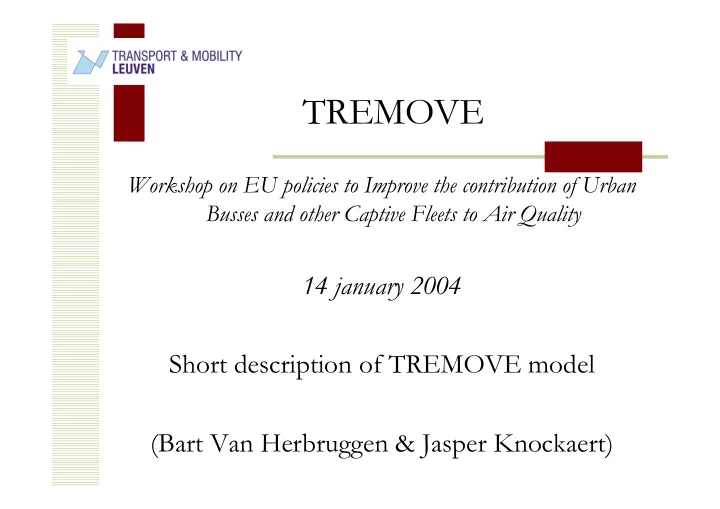

TREMOVE Workshop on EU policies to Improve the contribution of Urban Busses and other Captive Fleets to Air Quality 14 january 2004 Short description of TREMOVE model (Bart Van Herbruggen & Jasper Knockaert)
Major project outputs 1. Transport and emissions Baseline (2020) • Transport Activity • Vehicle stock turnover • Emissions & Energy consumption Consistency with other European models (SCENES , PRIMES , RAINS) Preference for EU data sources (EUROSTAT, COPERT, ARTEMIS) Stakeholder consultation and agreement
Major project outputs 2. Simulation tool for policy evaluation • Clean Air for Europe Programme • Greenhouse Gas Policies • Road Charging Policies • Energy Related Polices • Assessment of new road technologies • ...
Geoghraphical scope � EU 15 + CH + NO + SI + PL + CZ + HU � Each country consists of 3 model regions « aggregated » treatment of urban transport Metropolitan other urban non-urban Urban Non-Urban
Modal scope (passenger transport) � Car • Metro & Tram � Motorcycle • Train � Bus • Air � Coach • Non-motorised � Moped • Ferries
(freight transport) � Heavy duty truck � Light duty truck � Inland waterway � Rail � Maritime
Modular structure Consumer utility, Producer costs & Tax revenues Speed & Load Fuel Vehicle Welfare cost Transport consumption Traffic Stock stock module demand demand structure and emissions turnover External module module module Costs Usage Emissions by Vkm by type Activity by vehicle type and tech mode Stock Usage Life cycle structure emissions module Usage Fuel consumption Cost
How to simulate e.g. CNG bus subsidising In vehicle stock module (iteration over years): Total urban bus fleet : Stock i (t) = Stock i (t-1) - Scrap i (t) + Sale i (t) Modelling diesel versus CNG bus fleet Sales = choice models using nested logit functions and cost/tax/subsidy parameters The logit model enables to simulate the effect of subsidies to CNG busses on their market penetration
How to simulate e.g. CNG bus subsidising In transport demand module (iteration over years) : Penetration of subsidised CNG busses in the fleet might lead to changes in tariffs for public transport users This leads to modal shifts… This leads to changes in congestion levels and avg. speeds … A new equilibrium on the transport market is calculated
How to simulate e.g. CNG bus subsidising In emission module (iteration over years) : Changes in transport quantities by mode Changes in fleet composition for each mode ⇒ Effects on fuel consumption and emissions compared to the baseline ⇒ The lifecycle module deals with second-order emissions resulting from increased CNG use
How to simulate e.g. CNG bus subsidising In welfare module : � Changes in utility of consumers � Transport price and time cost changes � Transport quantitity changes (and change in consumption of other goods) � Changes in industries production costs � Changes in governments budgets (bus subsidy compensated by eg labour tax increase or cuts in investments) � Changes in external costs of pollution + => overall welfare effect
� WWW.TREMOVE.ORG
Recommend
More recommend